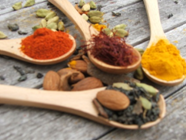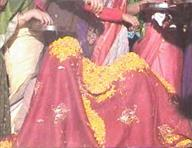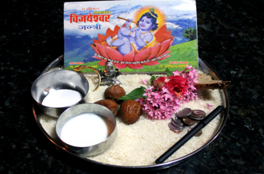Culture
General
The Kashmiri Pundits are a community from the Kashmir Valley located in the mountainous region of Jammu and Kashmir in India. Jammu and Kashmir consists of three main regions, which are Jammu, the Kashmir Valley and Ladakh. The Kashmir valley is famous for its picturesque mountainous landscape, with Jammu attracting thousands of people for its famous ancient shrines. Kashmiri philosophy and traditions can be traced back to over 5000 years, a testament to the rich culture of the Kashmiri Pundits.
Landscape
The landscape of the Jammu and Kashmir can be divided into the subtropical foothills of Jammu, the splendid Kashmir Valley that lies between mountains of the Himalayas and finally the cold desert of Ladakh. The landscape and respective climate has offered this state the lush forests, clear blue lakes, sparkling rivers, fertile lands and the back drop of snow-capped mountains. Each nook and corner of the state has something to offer to its people and travellers. Srinagar is the summer capital, and Jammu is the winter capital. The mountainous geography of the Kashmir Valley has played a significant role it shaping Kashmiri Pundit culture embodied in Kashmiri food and clothing.
Clothing
The traditional dresses of Jammu and Kashmir are renowned for their embroidery and intricate designs that reflect the rich culture and landscape of the region. The clothing is designed to primarily counter the cold climate of the region, evolving and changing over many years throughout Kashmir’s long history. The most iconic form of clothing is the “pheran” which is a full sleeved dress worn by both pundit males and females. The dress is worn with an under layer called a “potsh” which is made up of light white cotton. Female pherans consist of wider sleeves with fringed or embroidered stripes where as the traditional male garment is plain with narrow sleeves. In summer, the pheran and potsh are made of cotton, but in winter the potsh are made out of cotton and the phiran of wool. Women also wore the traditional headdress called a “taranga” alongside the pheran. It consists of a brightly coloured scarf that is stitched to a suspended cap. In modern times it is only worn by the bride at traditional Kashmiri pundit weddings. Earrings, anklets and bangles are widely worn. In particular is the “Dejharoos” which are two decorative gold pendants, which are suspended through gold chains or silk threads in the ear. It is symbolic of a woman’s married status among the Kashmiri Pundits.
Food
Kashmiri Pundits have had a significant influence on Kashmiri cuisine. Kashmiri food makes an extensive use of turmeric and yoghurt, with little use of garlic and onion unlike in other Indian cuisines. One of the most famous Kashmiri dishes, popular all around the world, is Rogan Josh, a lamb based dish, cooked in gravy seasoned with liberal amounts of Kashmiri chilies, ginger, asafetida and bay leaves among other ingredients. This dish is the most commonly cooked dish using lamb meat in Kashmiri cuisine. Tea drinking forms a very important of Kashmiri Pundit cuisine and often takes the place of dessert, with the most popular tea called Kehwa which is a sweet green tea mixed with cardamom and almonds.

Typical spices
Traditions
Weddings
Pre wedding
The “divgon” is a ceremony that marks the transition of the bride and the groom from brahmacharya ashram to grihastha ashram. The bride and the groom worship God Shiva and Goddess Parvati. This ceremony is performed separately by the bride and groom’s family in their respective homes. Before participating in the rituals, the relatives of the bride and the groom observe a fast.
Wedding ceremony
They most significant ceremony of a Kashmiri pundit wedding begins with the lighting of the holy fire where the couple is made to see each other through the images formed in a mirror. They then hold hands, which is covered with a cloth called “athwas”. The left foot of both the bride and the groom are placed on a kajwat (grinding stone) praying for a rock-solid future ahead. This is followed by the “phera” or rounds around the fire. The first phera is made by stepping on seven one-rupee coins. After the completion of the seven pheras, the couple is received by the groom's father who blesses the newlyweds.
The posh puza is a significant ceremony that formally ends the wedding ceremony.  A red cloth is placed on the newlyweds' heads, following which everyone present showers them with posh (flowers) accompanied by Vedic mantras. The couple, considered to be the embodiment of Lord Shiva and Goddess Parvati, are duly worshiped. With the wedding ceremony over, all the guests including the newlyweds head for dinner (a vegetarian fare) where they are made to eat from the same plate.
A red cloth is placed on the newlyweds' heads, following which everyone present showers them with posh (flowers) accompanied by Vedic mantras. The couple, considered to be the embodiment of Lord Shiva and Goddess Parvati, are duly worshiped. With the wedding ceremony over, all the guests including the newlyweds head for dinner (a vegetarian fare) where they are made to eat from the same plate.
Post Wedding
Departure from bride’s House - The newlywed couple now stands on a vyoog (Geometrical shapes drawn with bright colours at the entrance which ward off evil) while the eldest female member of the bride's family feeds them nabad ( sweets ) thrice and kisses them on the forehead.
Arrival At House - After arriving at the groom’s house they are then made to stand on a vyoog, offered nabad, and kissed on the forehead where they then share a family meal. After the meal, the bride changes into a new sari and jewellery given by her in-laws. Ataharu which consists of several strands of gold/silver tassels are strung below the dejaharu, signifying that the bride is now a married lady.
Yagneopavit
Yagneopavit, also known as the sacred thread ceremony, is a tradition held for the male of a pundit family at the age of 13. The function typically runs for 1 or 2 days and involves the whole family. During the festival the boy’s head is shaved and he is dressed in a saffron coloured thread holding a long stick in his right hand. The sacred thread consists of three strands knotted together that denote the three functions of thinking, speaking, and acting only for spiritual purposes.
Shivratri
Shivratri, often regarded as the most important festival of the Kashmiri community, celebrates the marriage of Lord Shiva and Goddess Parvarti. The festival is principally celebrated by offerings of Bael leaves to Shiva, all-day fasting and an all-night-vigil (jagaran). All through the day devotees chant "Om Namah Shivaya", the sacred mantra of Shiva.
Navreh
Navreh is the lunar new year which is celebrated in Kashmir and coincides with the first day of the spring.  It also signifies the beginning of the New Year for Kashmiri pundits and the word 'Navreh' is derived from Sanskrit 'Nava Varsha' meaning the New Year. In Kashmir the day is celebrated with great enthusiasm and sanctity. After taking a viewing of the Thal arranged the previous night, on Navreh, people prepare extravagant dishes with relatives and friends joining to offer greetings and well wishes. Newly wedded brides go their homes donning new clothes whilst carrying bread and sweets. Often new brides and children are given money by their elders.
It also signifies the beginning of the New Year for Kashmiri pundits and the word 'Navreh' is derived from Sanskrit 'Nava Varsha' meaning the New Year. In Kashmir the day is celebrated with great enthusiasm and sanctity. After taking a viewing of the Thal arranged the previous night, on Navreh, people prepare extravagant dishes with relatives and friends joining to offer greetings and well wishes. Newly wedded brides go their homes donning new clothes whilst carrying bread and sweets. Often new brides and children are given money by their elders.
(Courtesy KOA USA Inc., compiled by Samira Wakhlu)
